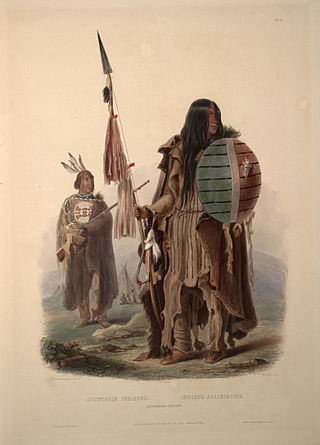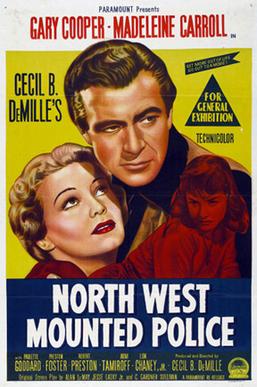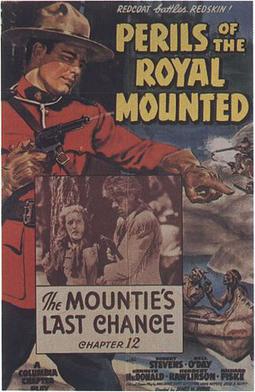
The Crow, whose autonym is Apsáalooke, also spelled Absaroka, are Native Americans living primarily in southern Montana. Today, the Crow people have a federally recognized tribe, the Crow Tribe of Montana, with an Indian reservation, the Crow Indian Reservation, located in the south-central part of the state.

The Blackfoot Confederacy, Niitsitapi, or Siksikaitsitapi, is a historic collective name for linguistically related groups that make up the Blackfoot or Blackfeet people: the Siksika ("Blackfoot"), the Kainai or Blood, and two sections of the Peigan or Piikani – the Northern Piikani (Aapátohsipikáni) and the Southern Piikani. Broader definitions include groups such as the Tsúùtínà (Sarcee) and A'aninin who spoke quite different languages but allied with or joined the Blackfoot Confederacy.

The Kainai Nation is a First Nations band government in southern Alberta, Canada, with a population of 12,800 members in 2015, up from 11,791 in December 2013.

The Assiniboine or Assiniboin people, also known as the Hohe and known by the endonym Nakota, are a First Nations/Native American people originally from the Northern Great Plains of North America.

The Gros Ventre, also known as the Aaniiih, A'aninin, Haaninin, Atsina, and White Clay, are a historically Algonquian-speaking Native American tribe located in northcentral Montana. Today, the Gros Ventre people are enrolled in the Fort Belknap Indian Community of the Fort Belknap Reservation of Montana, a federally recognized tribe with 7,000 members, also including the Assiniboine people.

Josephine M. Workman better known by her stage name, Princess Mona Darkfeather was an American actress who starred in Native American and Western dramas. During the silent era of motion pictures, from 1911 to 1917, she appeared in 102 movies. She is best known for her role as Prairie Flower in The Vanishing Tribe (1914).

Rebecca of Sunnybrook Farm is a 1938 American musical comedy film directed by Allan Dwan, and written by Don Ettlinger, Karl Tunberg, Ben Markson and William M. Conselman, the third adaptation of Kate Douglas Wiggin's 1903 novel of the same name.

John Farrell MacDonald was an American character actor and director. He played supporting roles and occasional leads. He appeared in over 325 films over a four-decade career from 1911 to 1951, and directed forty-four silent films from 1912 to 1917.
Cattle Queen of Montana is a 1954 American Western film shot in Technicolor directed by Allan Dwan and starring Barbara Stanwyck and Ronald Reagan. The supporting cast includes Gene Evans, Lance Fuller, Jack Elam, Chubby Johnson, and Morris Ankrum.

William Alfred Seiter was an American film director.

North West Mounted Police is a 1940 American epic north-western film produced and directed by Cecil B. DeMille and starring Gary Cooper and Madeleine Carroll. Written by Alan Le May, Jesse Lasky Jr., and C. Gardner Sullivan, and based on the 1938 novel The Royal Canadian Mounted Police by R. C. Fetherstonhaugh, the film is about a Texas Ranger who joins forces with the North-West Mounted Police to put down a rebellion in the north-west prairies of Canada. The supporting cast features Paulette Goddard, Preston Foster, Robert Preston, Akim Tamiroff, Lon Chaney Jr. and George Bancroft. Regis Toomey, Richard Denning, Rod Cameron, and Robert Ryan make brief appearances in the film playing small roles.

Victor Daniels, known professionally as Chief Thundercloud, was an American character actor in Westerns. He is noted for being the first actor to play the role of Tonto, the Lone Ranger's Native-American companion, on the screen.

Chief John Big Tree was a member of the Seneca Nation and an actor who appeared in 59 films between 1915 and 1950. He was born in Buffalo, New York and died in Onondaga Indian Reservation, New York. His interment was also there.

Perils of the Royal Mounted is a 1942 American Northern film. It was the 18th serial released by Columbia Pictures. It starred Robert Kellard as the hero, Sgt. Mack MacLane of the Royal Mounties, and Kenneth MacDonald as Mort Ramsome, the head villain. It also co-starred Nell O'Day, Iron Eyes Cody, Kermit Maynard and I. Stanford Jolley.

Gunfighters of the Northwest is a 1954 American Western serial film directed by Spencer Gordon Bennet and Charles S. Gould and starring Jock Mahoney, Clayton Moore, Phyllis Coates, Don C. Harvey.

Perils of the Wilderness is a 1956 American Western serial film directed by Spencer Gordon Bennet and starring Dennis Moore.

Stowaway is a 1936 American musical drama film directed by William A. Seiter. The screenplay by William M. Conselman, Nat Perrin, and Arthur Sheekman is based on a story by Samuel G. Engel. The film is about a young orphan called "Ching Ching" who meets wealthy playboy Tommy Randall in Shanghai and then accidentally stows away on the ocean liner he is travelling on. The film was hugely successful, and is available on videocassette and DVD.
Murder on the Campus is a 1933 American pre-Code mystery film directed by Richard Thorpe. The film is also known as On the Stroke of Nine in the United Kingdom. It is based on the novel The Campanile Murders, by Whitman Chambers.
The Iron Confederacy or Iron Confederation was a political and military alliance of Plains Indians of what is now Western Canada and the northern United States. This confederacy included various individual bands that formed political, hunting and military alliances in defense against common enemies. The ethnic groups that made up the Confederacy were the branches of the Cree that moved onto the Great Plains around 1740, the Saulteaux, the Nakoda or Stoney people also called Pwat or Assiniboine, and the Métis and Haudenosaunee. The Confederacy rose to predominance on the northern Plains during the height of the North American fur trade when they operated as middlemen controlling the flow of European goods, particularly guns and ammunition, to other Indigenous nations, and the flow of furs to the Hudson's Bay Company (HBC) and North West Company (NWC) trading posts. Its peoples later also played a major part in the bison (buffalo) hunt, and the pemmican trade. The decline of the fur trade and the collapse of the bison herds sapped the power of the Confederacy after the 1860s, and it could no longer act as a barrier to U.S. and Canadian expansion.

Prairie Thunder is a 1937 American Western film directed by B. Reeves Eason and written by Ed Earl Repp. The film stars Dick Foran, Janet Shaw, Frank Orth, Wilfred Lucas, Albert J. Smith and Yakima Canutt. The film was released by Warner Bros. on September 11, 1937. It was the last of 12 B-westerns Foran made for Warners as a singing cowboy from 1935 to 1937.

















